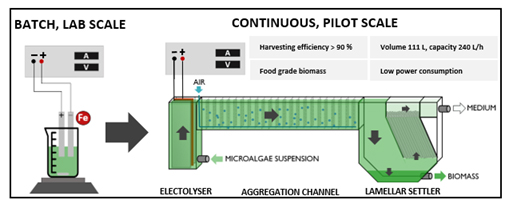Continuous electrocoagulation of microalga Chlorella vulgaris in a channel-flow reactor: A pilot-scale harvesting study
Although the biomass of photoautotrophically cultivated microalgae has a great potential for use in a wide range of industries (food, feed, pharmaceuticals, production of third-generation biofuels), further expansion is hindered by the relatively high price of microalgae biomass resulting from the difficulty of the production process, especially the separation of cells from the culture medium (so-called harvesting). The most commonly used method for harvesting microalgae on an industrial scale is centrifugation, which is, however, associated with very high energy costs. In order to reduce these costs, a continuous electrocoagulation process for harvesting the microalga Chlorella vulgaris was developed and tested. A flow-through device with a working volume of 111 L consisting of an electrolyzer with iron electrodes, an aggregation channel with perforated baffles, and a lamellar settling tank was constructed. The flow rate of the microalgae suspension through this device was 240 L/h. Using controlled cultivation and subsequent electrocoagulation, (i) low phosphate concentration in the culture medium, (ii) high harvesting efficiency (above 90 %), (iii) low contamination of harvested biomass with iron released during electrolysis from sacrificial anodes (less than 4 mg Fe/g dry biomass), so that harvested biomass met the legislative requirements for food, and (iv) significant energy savings were achieved. When comparing electrocoagulation and subsequent centrifugation with the use of centrifugation alone, the energy savings were approximately 80 % at a biomass concentration of 0.23 g/L, which corresponds approximately to the real harvesting concentration in large-scale microalgae cultivation.

- Lucáková S., Brányiková I.,* Kováčiková S., Masojídek J., Ranglová K., Brányik T., Růžička M.: Continuous electrocoagulation of Chlorella vulgaris in a novel channel-flow reactor: A pilot-scale harvesting study. Bioresource Technology 2022, 351(May 2022), 126996. doi: 10.1016/j.biortech.2022.126996